What Does Live Edge Mean?
Jun 16, 2020
Live-edge woodworking has become a must-know topic since I embarked in the field of harvesting, milling, and turning wood. If you follow rustic or organic interior designing, you’re in all likelihood aware of the popularity of live-edge woodworking.
What does live-edge actually mean? Live-edge defines the unfinished edge of the woodwork. It is the periphery of wood not altered by hand tools or woodworking machinery. As a result, the untouched end of slabs and furniture retains the original characteristics of a tree; its shape, and bark. This design element is referred to as a live-edge.
Live-edge has been used to describe a theme and genre of wood furniture making, wood art, and products. It is a style of woodworking where the artist incorporates the living edge of the wood into the finished product. And if you like the raw appeal of live-edge carpentry you’ll be happy to know that there is a large range of applications for live-edge.
Live-Edge Products
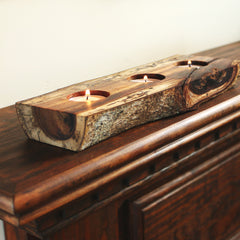 As the popularity of live edge design grows and technology in woodworking gets more advance we see more and more products made in the style of live-edge. Everything from lamps and frames to shelves and bar stools is designed to capture the raw lines and rustic appeal that live-edge woodwork offers. The side photo is an example of a live-edge home decor item. (Koa wood candle holder made from a branch.) As you can see, much of the bark is left intact.
As the popularity of live edge design grows and technology in woodworking gets more advance we see more and more products made in the style of live-edge. Everything from lamps and frames to shelves and bar stools is designed to capture the raw lines and rustic appeal that live-edge woodwork offers. The side photo is an example of a live-edge home decor item. (Koa wood candle holder made from a branch.) As you can see, much of the bark is left intact.
Live-Edge Tables
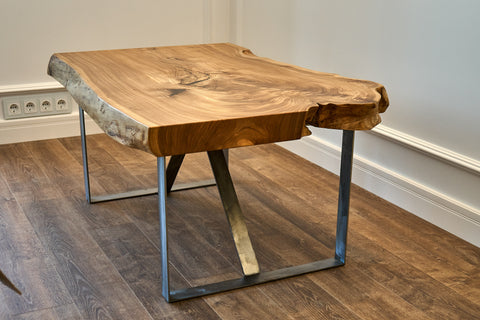
Perhaps the most popular application of live-edge design is in table making. Live-edge tables typically have at least one side, sometimes both sides of the table untouched. Unlike traditionally finished tables, a live-edge table brings the natural lines of the tree into the living space. By design, it brings the appearance of outdoors inside. Custom made by mother nature, each piece is just as unique as fingerprints.
Live-Edge Turned Bowls
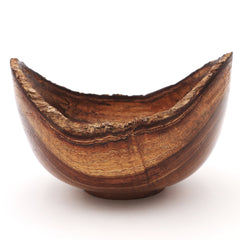 My first hands-on experience working with live-edge wood was through woodturning. Turning live-edge Koa wood bowls is particularly fun for me. Because of the organic nature and odd cross-section shape that live-edge turning produces, it creates a truly unique art piece. This is most evident in the natural lines of the bowl’s rim. It isn't straight, the edge of the rim is not only uniquely made up of the untouched edge of the tree, but the rim line is wavy and irregular.
My first hands-on experience working with live-edge wood was through woodturning. Turning live-edge Koa wood bowls is particularly fun for me. Because of the organic nature and odd cross-section shape that live-edge turning produces, it creates a truly unique art piece. This is most evident in the natural lines of the bowl’s rim. It isn't straight, the edge of the rim is not only uniquely made up of the untouched edge of the tree, but the rim line is wavy and irregular.
I get the most positive responses and interest in my live edge pieces. Live-edge pieces are my best sellers.
When making live edge Koa bowls I start with what appears to be a cross-section cut of the wood. I pay special attention to the bark to ensure it isn’t in decay. I want to preserve the bark as best as possible because I have a preference for the look of bowls that have the bark preserved. That said, if the bark does fall off I refer to it as a natural edge.
Live-Edge, Natural Edge, and Living Edge
The terminology difference between “live-edge” and “natural edge” is loose. This is often debated in woodworking circles. Some say it's the same meaning while others argue that when the bark is removed it is no longer a "live-edge" and instead "natural." I tend to agree and apply the term natural edge when describing the raw organic shape of the edge without the bark, and I use live-edge terminology if the piece still has the bark. I differentiate my bowls this way.
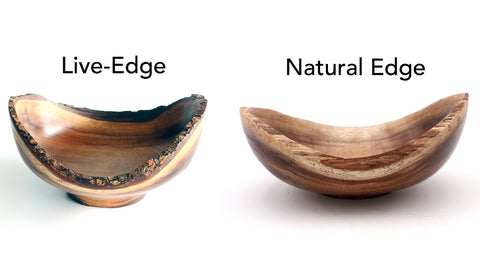
Another term, to note that is often interchangeably used with live-edge is "living-edge." It references the same meaning as live-edge.
It All Begins with the Lumber
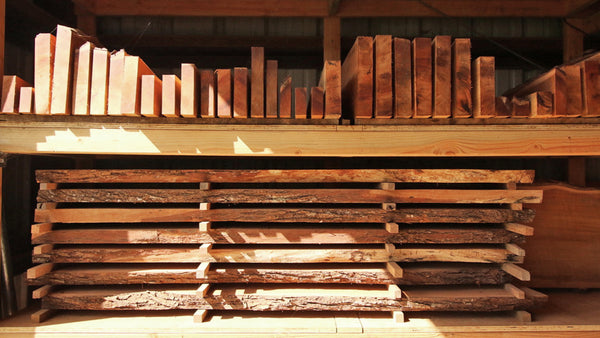
Whether it’s a live-edge table or wood bowl, all woodworking projects start with live-edge lumber.
For the construction of tables, it begins with the live-edge wood slab. These pieces are cuts of wood that do not have finished edges. Unlike traditional lumber that comes with a straight side, the contour on a live-edge slab mimics that of the original tree.
Slabs can come in thicknesses of 1” to 3” depending upon the intended use. 1-2” thicknesses are typically geared to specialty woodworking and 3” is more common for making dining or conference tables.
Working with Live-Edge
Live-edge woodwork is a bit more complex than working with regular dimensional lumber. Special consideration has to be given to a wood project when considering live edge design.
- Unlike square and finished wood, live-edges can come with holes, cracks, and voids. These often require some kind of filling with resin or filler.
- Being organic, live edges are not straight. This presents a multitude of challenges when cutting and measuring.
- The bark is subject to decay and can fall apart as wood expands and contracts. Many woodworkers remove the bark entirely and leave only a natural edge.
Is Live-Edge Expensive?
Generally speaking the extra care and attention that live-edge wood requires does drive up the cost of live-edge lumber and finished goods. Cutting and stocking traditional lumber in bulk is much easier and cheaper for most suppliers. As a woodworker myself I can tell you that working with live-edge wood requires much more time and labor, therefore, it drives up cost. Live-edge lumber and finished goods are more expensive than traditional lumber and finished wood items.
History of Live Edge
Live edge woodworking design started off as a necessity. Early American settlers, building in new territory, needed a way to build functional furniture for their families quickly. Time was precious so trees were simply sawn into on pieces of unfinished slabs to build basic furniture.
Midcentury modern woodworker, architect and furniture-maker George Nakashima (1905-1990), known for leaving the natural edge of the wood as part of the finished piece, is credited with igniting the popularity and inspiration behind the live-edge design we see today. He used irregular timber edges as a design element in his furniture.
Nakashima studied architecture at M.I.T. and then went to Japan to study traditional Japanese design and joinery. His first use of live-edge in his work came after his return to the US, right after World War II.
"In Japanese, kodama, the "spirit of a tree," refers to a feeling of special kinship with the heart of a tree. It is our deepest respect for the tree...that we may offer the tree a second life." - George Nakashima
His designs were unique in that they expressed a huge appreciation for the imperfection of wood. Imperfections in the grain, cracks, holes, and bark were celebrated in his work. He brought live-edge into the realm of fine furniture in a way that no one had done before. For example, Nakashima made famous the use of butterfly joints, which stitched together cracks in the lumber at a time when other woodworkers would have otherwise sawn away the lumber. His perspective, contribution, and work was unique at the time and helped shape the current attraction and inspiration for live edge furnishings.
Where Can I Find Live-Edge Products?
Given the current popularity of live-edge woodworking and design, live-edge products can be found everywhere. Home decor and furniture are easily found in big-box and specialty stores to small artists on Etsy and yours truly on this website. For slabs and turning blanks, most raw wood and lumber establishments have a wide selection. Our sister website (coming soon) carries Koa wood slabs. But if your handy and adventurous, pick up a chainsaw and head to the forest.



